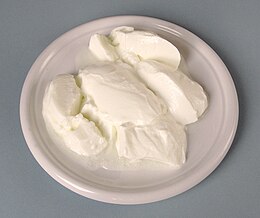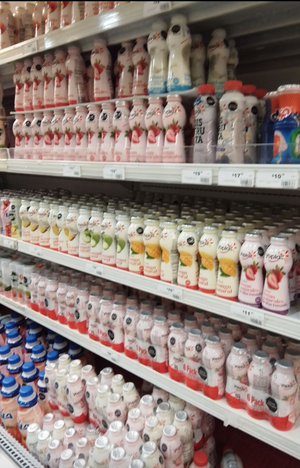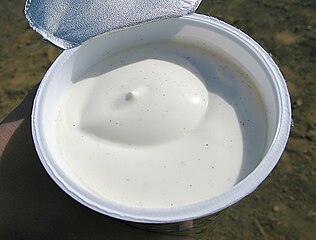ヨーグルト
Yogurt/ja
| ヨーグルト | |
|---|---|
 A plate of yogurt | |
| 種類 | 発酵乳製品 |
| 発祥地 | 紀元前5000年頃のメソポタミアや中央アジア、そして独自に様々な場所で |
| 提供時温度 | チルド |
| 主な材料 | 牛乳、バクテリア |
ヨーグルト (英語発音: UK: /ˈjɒɡət/, US: /ˈyoʊɡərt/、オスマン語: یوغورت、トルコ語: yoğurtが語源。yoghurt、yogourt、yoghourtとも表記される) は、牛乳を細菌発酵させて作る食品である。牛乳中の糖分がこれらの細菌によって発酵すると乳酸が生成されるんだけど、この乳酸が乳タンパク質に作用して、ヨーグルト独特の食感と特徴的な酸味を生み出す。 ヨーグルトの製造には牛乳が最も一般的に使われるけど、水牛、ヤギ、羊(雌羊)、馬、ラクダ、ヤクの乳も使われることがある。使われる乳は均質化されていてもされていなくてもいいし、低温殺菌されたものでも生乳でもかまわない。ただし、乳の種類によって出来上がるヨーグルトはかなり異なるものになる。
ヨーグルトは、主に「ラクトバチルス・デルブルエッキー亜種ブルガリクス」と「ストレプトコッカス・サーモフィルス」という細菌の培養を使って作られる。培養中や培養後に、他の乳酸菌やビフィズス菌が加えられることもある。 一部の国では、ヨーグルトに含まれる細菌の「コロニー形成単位(CFU)」の量を特定する規制がある。例えば、中国では1ミリリットルあたり100万CFU以上の乳酸菌が必要とされている。また、使用できる細菌の種類を規制している国もある。例えば、フランスでは、「ヨーグルト」または「ヨーグー」として表示できるのは、ラクトバチルス・デルブルエッキー亜種ブルガリクスとストレプトコッカス・サーモフィルスのみで発酵させた製品に限られていて、これは発酵乳に関する「コーデックス委員会」の国際的なヨーグルトの定義(CXS 243-2003)に合致する要件である。
細菌培養液が混ざったら、30–45 °C (86–113 °F)の暖かい温度を4〜12時間保つ。これは発酵を進めるた目である。温度が高いほど発酵は早く進むけど、その分、塊になったり乳清(ホエイ)が分離したりするリスクが高まる。
語源と綴り
ヨーグルトという言葉は、オスマン語の「یوغورت」(yoğurt)に由来していて、通常はトルコ語の動詞「yoğurmak」(「こねる」または「凝固する、濃くなる」)に関連している。「yoğun」(厚い、密な)という言葉とも関係があるかもしれない。 トルコ語のアラビア文字「غ(ghayn)」で歴史的に表されてきた音は、有声軟口蓋摩擦音から有声軟口蓋破裂音まで様々だったが、1929年にアタチュルクの改革による新しいラテン語ベースのトルコ語アルファベットと文字「ğ」が導入されるまでは、伝統的に「gh」とローマ字表記されていた。だから、「gh」と綴られた「yoghurt」は、1615年から1625年の文献で初めて確認されている。
英語におけるヨーグルトの綴りには、yogurt、yoghurtがあり、yoghourtやyogourtはそれほど一般的ではない。イギリス、オーストラリア、ニュージーランド、南アフリカでは通常「yoghurt」と綴られるが、アメリカ合衆国では「yogurt」が用いられる。カナダでは、フランス語の「yaourt」の少数派である「yogourt」という独自の綴りがあるが、「yogurt」や「yoghurt」も使用されている。
歴史
L. delbrueckii subsp. bulgaricus のゲノム解析から、この細菌は植物の表面が起源である可能性があることが示唆されている。乳が植物との接触によって偶発的かつ意図せずこの細菌に触れたか、あるいは家畜の乳生産動物の乳房から細菌が移動したのかもしれない。 ヨーグルトの起源は不明だが、おそらく紀元前5000年頃、最初の乳生産動物が家畜化された中央アジアやメソポタミアで、新石器時代の人々によって最初に発見されたのだろう。彼らは偶然に乳を発酵させる方法を見つけたとされ、ヨーグルトは様々な場所で異なる時期に、このようにして独自に発見された可能性が高い。

古代ギリシャの料理には、「オキシガラ(古希: οξύγαλα)」として知られる乳製品が含まれており、これはヨーグルトの一種だった。ガレノス(紀元129年頃 - 200年/216年頃)は、オキシガラがハチミツと一緒に食べられていたと述べており、これは今日の濃厚なギリシャヨーグルトの食べ方に似ている。 ヨーグルトに言及する最も古い文献は大プリニウスに帰されており、彼はある種の「野蛮な民族」が「乳を好ましい酸味のある物質に凝固させる」方法を知っていたと述べている。中世のテュルク系民族によるヨーグルトの使用は、11世紀に書かれたマフムード・カーシュガリーのディーワーン・ルガート・アットゥルクとユースフ・ハース・ハージブのクタドゥグ・ビリグに記録されている。両方の文献は異なる箇所で「ヨーグルト」という言葉に言及し、遊牧民のテュルク系民族によるその使用について記述している。初期のヨーグルトは、おそらく山羊の皮袋の中で野生の細菌によって自然に発酵したものだろう。
いくつかの記述によれば、ムガル帝国の皇帝アクバルの料理人たちは、ヨーグルトにマスタードシードやシナモンで風味を付けていたとされる。ヨーロッパでヨーグルトに遭遇した別の初期の記述は、フランスの臨床史に見られる。フランソワ1世は重度の下痢に苦しんでいたが、どのフランス人医師も治すことができなかった。彼の同盟者であったスレイマン1世は医師を送り、その医師はヨーグルトで患者を治したとされている。感謝した国王は、自分を治したその食品について多くの人に語った。
1900年代まで、ヨーグルトはロシア帝国(特に中央アジアやコーカサス)、西アジア、南東ヨーロッパ/バルカン半島、中央ヨーロッパ、そしてインド亜大陸の人々の食生活における主要な食品であった。ジュネーブの医学部に留学していたブルガリア人のスタメン・グリゴロフ(1878-1945)は、ブルガリアヨーグルトの微生物叢を初めて研究した。1905年、彼はそれが球菌と桿菌の乳酸産生細菌からなると記述した。1907年には、桿菌がBacillus bulgaricus(現在のLactobacillus delbrueckii subsp. bulgaricus)と命名された。パリのパスツール研究所のロシア人生物学者でノーベル賞受賞者のイリヤ・メチニコフは、グリゴロフの研究に影響を受け、ヨーグルトを定期的に摂取することがブルガリア人農民の異常な長寿の原因であると仮説を立てた。メチニコフはラクトバチルスが健康に不可欠であると信じ、ヨーロッパ中でヨーグルトを食品として普及させるために尽力した。
ヨーグルトの工業化は、1919年にスペインのバルセロナで小さなヨーグルト事業を始めたアイザック・カラッソによるものだ。彼は息子にちなんでその事業を「ダノン」(小さなダニエル)と名付けた。このブランドは後に、アメリカ式の名称であるダノンとしてアメリカ合衆国に拡大した。果物のジャムが加えられたヨーグルトは、1933年にプラハのラドリカ乳製品会社によって特許が取得された。
ヨーグルトがアメリカ合衆国に導入されたのは20世紀の最初の10年間で、これはイリヤ・メチニコフの『The Prolongation of Life; Optimistic Studies』(1908年)に影響されたものだ。消化不良の人や自宅で培養したい人のために、錠剤の形で入手できた。バトルクリーク・サナトリウムのジョン・ハーヴェイ・ケロッグによって、経口摂取と浣腸の両方で用いられ、その後に普及した。そして、1929年にマサチューセッツ州アンドーバーで「コロンボ・アンド・サンズ・クリーマリー」を始めたアルメニア人移民のサルキスとローズ・コロンボシアンによってさらに普及した。
コロンボヨーグルトは当初、ニューイングランド地方で馬車にmadzoonというアルメニア語を刻んで配達されていたが、後に「ヨーグルト」というトルコ語の製品名に変更された。当時、主要な消費者であった近東の様々な民族の移民の間ではトルコ語が共通語であったためだ。アメリカ合衆国におけるヨーグルトの人気は、ハンガリー生まれの細菌学者スティーブン・A・ゲイモントのような科学者によって健康食品として紹介された1950年代から1960年代にかけて高まった。しかし、プレーンヨーグルトは依然としてアメリカ人の味覚には酸っぱすぎるとされ、1966年にコロンボヨーグルトはヨーグルトを甘くしてフルーツの砂糖漬けを加え、「フルーツ・オン・ザ・ボトム」スタイルのヨーグルトを生み出した。これは成功し、会社の売上はすぐに年間100万ドルを超えた。20世紀後半までに、ヨーグルトはアメリカの一般的な食品となり、コロンボヨーグルトは1993年にゼネラル・ミルズに売却されたが、同ブランドは2010年に廃止された。
栄養
| Nutritional value per 100 g (3.5 oz) | |||||||||||||||||||||||||||||||||||||||||||||||||
|---|---|---|---|---|---|---|---|---|---|---|---|---|---|---|---|---|---|---|---|---|---|---|---|---|---|---|---|---|---|---|---|---|---|---|---|---|---|---|---|---|---|---|---|---|---|---|---|---|---|
| Energy | 406 kJ (97 kcal) | ||||||||||||||||||||||||||||||||||||||||||||||||
3.98 g | |||||||||||||||||||||||||||||||||||||||||||||||||
| Sugars | 4.0 g | ||||||||||||||||||||||||||||||||||||||||||||||||
| Dietary fiber | 0 g | ||||||||||||||||||||||||||||||||||||||||||||||||
5.0 g | |||||||||||||||||||||||||||||||||||||||||||||||||
9.0 g | |||||||||||||||||||||||||||||||||||||||||||||||||
| |||||||||||||||||||||||||||||||||||||||||||||||||
| Other constituents | Quantity | ||||||||||||||||||||||||||||||||||||||||||||||||
| Selenium | 9.7 µg | ||||||||||||||||||||||||||||||||||||||||||||||||
| Water | 81.3 g | ||||||||||||||||||||||||||||||||||||||||||||||||
| †Percentages estimated using US recommendations for adults, except for potassium, which is estimated based on expert recommendation from the National Academies. | |||||||||||||||||||||||||||||||||||||||||||||||||
プレーンヨーグルト(全乳製)は、水分が81%、タンパク質が9%、脂肪が5%、そして炭水化物が4%(そのうち糖質が4%)で構成されている。100グラムあたり406 kilojoules (97 kcal)の食事エネルギーを供給する。 1日の摂取目安量(DV)を基準とすると、ヨーグルト1食分はビタミンB12(DVの31%)とリボフラビン(DVの23%)の豊富な供給源である。また、タンパク質、リン、セレンも適度な量(DVの14〜19%)含まれている。
| Property | 牛乳 | ヨーグルト |
|---|---|---|
| エネルギー | 610 kJ (146 kcal) | 620 kJ (149 kcal) |
| 総炭水化物 | 12.8 g | 12 g |
| 総脂肪 | 7.9 g | 8.5 g |
| コレステロール | 24 mg | 32 mg |
| タンパク質 | 7.9 g | 9 g |
| カルシウム | 276 mg | 296 mg |
| リン | 222 mg | 233 mg |
| カリウム | 349 mg | 380 mg |
| ナトリウム | 98 mg | 113 mg |
| ビタミンA | 249 IU | 243 IU |
| ビタミンC | 0.0 mg | 1.2 mg |
| ビタミンD | 96.5 IU | ~ |
| ビタミンE | 0.1 mg | 0.1 mg |
| ビタミンK | 0.5 μg | 0.5 μg |
| チアミン | 0.1 mg | 0.1 mg |
| リボフラビン | 0.3 mg | 0.3 mg |
| ナイアシン | 0.3 mg | 0.2 mg |
| ビタミンB6 | 0.1 mg | 0.1 mg |
| 葉酸 | 12.2 μg | 17.2 μg |
| ビタミンB12 | 1.1 μg | 0.9 μg |
| コリン | 34.9 mg | 37.2 mg |
| ベタイン | 1.5 mg | ~ |
| 水 | 215 g | 215 g |
| 灰 | 1.7 g | 1.8 g |
チルダ(~)は、欠損データまたは不完全なデータを表す。 上記は、記載されている栄養成分に関して、全乳と全乳から作られたヨーグルトの間にほとんど違いがないことを示している。
健康研究
生きた菌を含む可能性があるため、ヨーグルトはしばしばプロバイオティクスと関連付けられる。プロバイオティクスは、免疫、心血管、または代謝の健康に良い影響を与えると提唱されてきた。
21世紀初頭の時点では、ヨーグルトの摂取が病気のリスクを低減したり、その他健康を改善したりすると結論付けるための質の高い臨床的証拠は不十分であった。しかし、メタアナリシスでは、1日あたり80グラムの低脂肪ヨーグルトを摂取することが、2型糖尿病の発症リスクの低下や、閉経後女性の股関節骨折発生率の低下と関連していることが判明した。2021年のレビューでは、ヨーグルトの摂取と乳糖耐性および消化の改善との間に因果関係があること、そしてヨーグルトの摂取と骨の健康の改善、さらに癌やメタボリックシンドロームを含むいくつかの病気のリスク低下との間に潜在的な関連性が存在することが示された。
安全性
生乳で作られたヨーグルトは、重篤な病気を引き起こし、死に至る可能性もある細菌(例えば、リステリア菌、クリプトスポリジウム、カンピロバクター、ブルセラ菌、大腸菌、サルモネラ菌など)に汚染される可能性がある。また、ヨーグルトはアフラトキシンを産生するAspergillus flavus、Aspergillus parasiticus、Aspergillus nomiusによって汚染される可能性もある。
伝統的に調製されたヨーグルトは、工業的に加工されたものよりも汚染が発生しやすいが、製造や包装の慣行が最適でない場合は後者にも影響を及ぼす可能性がある。
ヨーグルトにカビが発生した場合、それを削り取ることはできない。ヨーグルトの粘性により、カビが表面の下深くまで浸透して広がるためである。
種類と提供方法

Dahi is a yogurt from the Indian subcontinent, known for its characteristic taste and consistency. The word dahi seems to be derived from the Sanskrit word dadhi ("sour milk"), one of the five elixirs, or panchamrita, often used in Hindu ritual. Sweetened dahi (mishti doi or meethi dahi) is common in eastern parts of India, made by fermenting sweetened milk. While cow's milk is currently the primary ingredient for yogurt, goat and buffalo milk were widely used in the past, and valued for the fat content (see buffalo curd).
Dadiah or dadih is a traditional West Sumatran yogurt made from water buffalo milk, fermented in bamboo tubes. Yogurt is common in Nepal, where it is served as both an appetizer and dessert. Locally called dahi, it is a part of the Nepali culture, used in local festivals, marriage ceremonies, parties, religious occasions, family gatherings, and so on. One Nepalese yogurt is called juju dhau, originating from the city of Bhaktapur. In Tibet, yak milk (technically dri milk, as the word yak refers to the male animal) is made into yogurt (and butter and cheese) and consumed.
In Northern Iran, Mâst Chekide is a variety of kefir yogurt with a distinct sour taste. It is usually mixed with a pesto-like water and fresh herb purée called delal. Common appetizers are spinach or eggplant borani, Mâst-o-Khiâr with cucumber, spring onions and herbs, and Mâst-Musir with wild shallots. In the summertime, yogurt and ice cubes are mixed together with cucumbers, raisins, salt, pepper and onions and topped with some croutons made of Persian traditional bread and served as a cold soup. Ashe-Mâst is a warm yogurt soup with fresh herbs, spinach and lentils. Even the leftover water extracted when straining yogurt is cooked to make a sour cream sauce called kashk, which is usually used as a topping on soups and stews.
Matsoni is a Georgian yogurt in the Caucasus and Russia. Tarator and cacık are cold soups made from yogurt during summertime in eastern Europe. They are made with ayran, cucumbers, dill, salt, olive oil, and optionally garlic and ground walnuts. Tzatziki in Greece and milk salad in Bulgaria are thick yogurt-based salads similar to tarator.
Khyar w Laban (cucumber and yogurt salad) is a dish in Lebanon and Syria. Also, a wide variety of local Lebanese and Syrian dishes are cooked with yogurt like "Kibbi bi Laban" Rahmjoghurt, a creamy yogurt with much higher fat content (10%) than many yogurts offered in English-speaking countries. Dovga, a yogurt soup cooked with a variety of herbs and rice, is served warm in winter or refreshingly cold in summer. Jameed, yogurt salted and dried to preserve it, is consumed in Jordan. Zabadi is the type of yogurt made in Egypt, usually from the milk of the Egyptian water buffalo. It is particularly associated with Ramadan fasting, as it is thought to prevent thirst during all-day fasting.
Sweetened and flavored
To offset its natural sourness, yogurt is also sold sweetened, sweetened and flavored or in containers with fruit or fruit jam on the bottom. The two styles of yogurt commonly found in the grocery store are set-style yogurt and Swiss-style yogurt. Set-style yogurt is poured into individual containers to set, while Swiss-style yogurt is stirred prior to packaging. Either may have fruit added to increase sweetness.
Lassi is a common Indian beverage made from stirred liquified yogurt that is either salted or sweetened with sugar commonly, less commonly honey and combined with fruit pulp to create flavored lassi. Consistency can vary widely, with urban and commercial lassis having uniform texture through being processed, whereas rural and rustic lassi has discernible curds or fruit pulp.
Large amounts of sugar – or other sweeteners for low-energy yogurts – are often used in commercial yogurt. Some yogurts contain added modified starch, pectin (found naturally in fruit) or gelatin to create thickness and creaminess. This type of yogurt may be marketed under the name Swiss-style, although it is unrelated to conventional Swiss yogurt. Some yogurts, often called "cream line", are made with whole milk which has not been homogenized so the cream rises to the top. In many countries, sweetened, flavored yogurt is common, typically sold in single-serving plastic cups. Common flavors may include vanilla, honey, and toffee, and various fruits. In the early 21st century, yogurt flavors inspired by desserts, such as chocolate or cheesecake, became common. There is concern about the health effects of sweetened yogurt due to its high sugar content, although research indicates that use of sugar in yogurt manufacturing has decreased since 2016 in response to WHO and government initiatives to combat obesity.
Straining

Strained yogurt has been strained through a filter, traditionally made of muslin and more recently of paper or non-muslin cloth. This removes the whey, giving a much thicker consistency. Strained yogurt is made at home, especially if using skimmed milk which results in a thinner consistency. Yogurt that has been strained to filter or remove the whey is known as Labneh in Middle Eastern countries. It has a consistency between that of yogurt and cheese. It may be used for sandwiches in Middle Eastern countries. Olive oil, cucumber slices, olives, and various green herbs may be added. It can be thickened further and rolled into balls, preserved in olive oil, and fermented for a few more weeks. It is sometimes used with onions, meat, and nuts as a stuffing for a variety of pies or kibbeh balls.
Some types of strained yogurts are boiled in open vats first, so that the liquid content is reduced. The East Indian dessert, a variation of traditional dahi called mishti dahi, offers a thicker, more custard-like consistency, and is usually sweeter than western yogurts. In western Indian (Marathi and Gujarati) cuisine, strained yogurt is macerated with sugar and spices such as saffron, cardamom and nutmeg to make the dessert "shrikhand". Strained yogurt is also enjoyed in Greece and is the main component of tzatziki (from Turkish "cacık"), a well-known accompaniment to gyros and souvlaki pita sandwiches: it is a yogurt sauce or dip made with the addition of grated cucumber, olive oil, salt and, optionally, mashed garlic. Srikhand, a dessert in India, is made from strained yogurt, saffron, cardamom, nutmeg and sugar and sometimes fruits such as mango or pineapple.
In North America, strained yogurt is commonly called "Greek yogurt". Powdered milk is sometimes added in lieu of straining to achieve thickness. In Britain, the name "Greek" may only be applied to yogurt made in Greece.
Beverages
Ayran, doogh ("dawghe" in Neo-Aramaic) or dhallë is a yogurt-based, salty drink. It is made by mixing yogurt with water and (sometimes) salt.
Borhani (or burhani) is a spicy yogurt drink from Bangladesh. It is usually served with kacchi biryani at weddings and special feasts. Key ingredients are yogurt blended with mint leaves (mentha), mustard seeds and black rock salt (Kala Namak). Ground roasted cumin, ground white pepper, green chili pepper paste and sugar are often added.
Lassi is a yogurt-based beverage that is usually slightly salty or sweet, and may be commercially flavored with rosewater, mango or other fruit juice. Salty lassi is usually flavored with ground, roasted cumin and red chilies, and may be made with buttermilk.
An unsweetened and unsalted yogurt drink usually called simply jogurt is consumed with burek and other baked goods in the Balkans. Sweetened yogurt drinks are the usual form in Europe (including the UK) and the US, containing fruit and added sweeteners. These are typically called "drinkable yogurt". Also available are "yogurt smoothies", which contain a higher proportion of fruit and are more like smoothies.
Production

Yogurt production involves preparing warm milk to a temperature (30–45 °C (86–113 °F)) that will not kill the live microorganisms that turn the milk into yogurt, inoculating certain bacteria (starter culture), usually Streptococcus thermophilus and Lactobacillus bulgaricus, into the milk, and finally keeping it warm for several hours (4–12 hours).
Milk with a higher concentration of solids than normal milk may be used; the higher solids content produces a firmer yogurt. Solids can be increased by adding dried milk. The yogurt-making process provides two significant barriers to pathogen growth, heat and acidity (low pH). Both are necessary to ensure a safe product. Acidity alone has been questioned by recent outbreaks of food poisoning by E. coli O157:H7 that is acid-tolerant. E. coli O157:H7 is easily destroyed by pasteurization (heating); the initial heating of the milk kills pathogens as well as denaturing proteins. The microorganisms that turn milk into yogurt can tolerate higher temperatures than most pathogens, so that a suitable temperature not only encourages the formation of yogurt, but inhibits pathogenic microorganisms. Once the yogurt has formed it can, if desired, be strained to reduce the whey content and thicken it.
Microstructure
Yogurt is characterized as a viscous, shear-thinning, non-Newtonian fluid that forms when milk, a Newtonian fluid, is fermented, causing protein aggregation and subsequent gelation. The result is a soft solid that can be modeled via the interactions of the casein proteins. The microstructure of yogurt is affected by both the fat and protein content and the processing conditions of the yogurt. In low-fat formulations, the microstructure is a network of casein protein globules joined via clusters and strands that encapsulate pores: these pores house the aqueous phase and the bacterial cultures of the yogurt.
Stirred yogurt formulations have a coarser distribution of loosely associated casein particulates due to the shear forces and resulting particle-particle collisions induced during the mixing process. After stirring, yogurt is more accurately defined as a weak gel.
Rheology
The mechanical properties of yogurt are typically assessed using rheometry, which quantifies the deformation and flow response of soft materials subject to shear forces. As is central in materials science, the rheological properties of yogurt are dictated by a variety of processing factors, including the ratios of dry and wet matter, thermal treatments, milk origin, starter cultures, and yogurt type.
Although cow milk is a common choice for yogurt production, other milks, such as goat, sheep, and camel, produce different rheologies. Goat milk yogurt has a low viscosity and a thinner texture when compared to cow milk yogurt. Conversely, sheep milk, having higher content of solids, has a higher viscosity and thicker texture when compared to cow milk yogurt.
Yogurt can further be characterized as "set" versus stirred, wherein set yogurts are processed and sold in the same container, and stirred yogurts are mixed prior to packaging in a secondary container.
商業
コーデックス委員会が輸出入を認めているヨーグルトには2種類ある。
- 殺菌ヨーグルト(「加熱処理発酵乳」と表示)は、細菌を殺すために殺菌されたヨーグルトである。
- プロバイオティックヨーグルト(「ライブヨーグルト」または「アクティブヨーグルト」と表示)は、細菌を殺すために殺菌されたヨーグルトに、包装前に計測された単位でラクトバチルスが添加されたものである。
- ヨーグルトプロバイオティックドリンクは、細菌を殺すために殺菌された飲用ヨーグルトに、包装前にラクトバチルスが添加されたものである。
米国食品医薬品局の規制では、牛乳は培養前に低温殺菌される必要があり、任意で培養後に加熱処理して保存期間を延ばすことができる。米国の市販ヨーグルトのほとんどは、培養後に加熱処理されておらず、生きた菌を含んでいる。
ライブカルチャーを含むヨーグルトは、乳糖吸収不良の人にとって、殺菌されたヨーグルトよりも有益である。
乳糖不耐症
乳糖不耐症とは、乳製品に含まれる糖である乳糖を消化する能力が低下したために症状が現れる状態である。2010年、欧州食品安全機関(EFSA)は、生きたヨーグルト培養菌(乳酸菌)を摂取することで、他の乳製品中の乳糖を消化できるようになり、乳糖不耐症が軽減される可能性があると判断した。EFSAによるこの科学的審査により、ヨーグルト製造業者は製品ラベルに健康強調表示を使用できるようになった。ただし、その条件として「ヨーグルトは1グラムあたり少なくとも108 CFUの生きたスターター微生物(Lactobacillus delbrueckii subsp. bulgaricusとStreptococcus thermophilus)を含んでいなければならない。対象となるのは乳糖消化不良の個人である」とされている。2021年のレビューでは、ヨーグルトの摂取が乳糖耐性と消化を改善する可能性が示されている。
植物性製品
2000年代に、様々な植物性ヨーグルト代替品が登場した。これらは豆乳、ライスミルク、そしてアーモンドミルクやココナッツミルクといったナッツミルクを発酵させて作られている。これらの製品は、乳糖不耐症の人々や、菜食主義者やヴィーガンなど、植物性食品を好む人々に適している。 植物性ミルクは、牛乳とは異なる構造と成分を持つ。牛乳から作られる多くの製品と同様の製品を作ることはできるが、味や食感に違いがあり、一部の消費者は「従来のヨーグルト」のような「繊細で滑らかな構造」に欠けると感じるかもしれない。植物性ミルクは乳糖(Streptococcus thermophilusとLactobacillus bulgaricusの餌となるもの)を含まないため、植物性製品には通常、ヨーグルトとは異なる細菌株、例えばLactobacillus casei、Lactobacillus rhamnosus、Bifidobacterium bifidumなどが含まれている。植物性製品はまた、栄養と成分が大きく異なり、ガム、安定剤、高甘味度甘味料、人工着色料などが含まれている場合がある。
ヨーロッパでは、欧州連合規則1308/2013および欧州司法裁判所の2017年の判決により、「ヨーグルト」という用語は動物由来の製品のみに限定されているため、企業は植物性製品を「ヨーグルト」という言葉を使って販売することはできない。2021年には、米国FDAの食品の同一性基準規制により、「ヨーグルト」という言葉は乳汁から作られた製品、すなわち「牛乳由来の成分」から作られた製品に限定されることが再確認された。
ギャラリー
関連項目
- Fermented milk products/ja
- Frozen yogurt/ja
- List of dairy products/ja
- プロバイオティクス
- List of yogurt-based dishes and beverages/ja
外部リンク
 The dictionary definition of yogurt/ja at Wiktionary
The dictionary definition of yogurt/ja at Wiktionary [[wikibooks:Cookbook:Yogurt/ja |]] at the Wikibooks Cookbook subproject
[[wikibooks:Cookbook:Yogurt/ja |]] at the Wikibooks Cookbook subproject
| この記事は、クリエイティブ・コモンズ・表示・継承ライセンス3.0のもとで公表されたウィキペディアの項目Yogurt(28 May 2025, at 23:30編集記事参照)を翻訳して二次利用しています。 |







